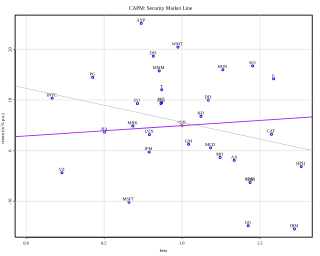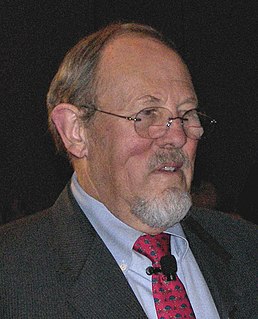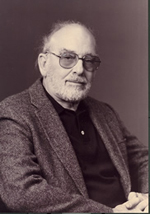Related Research Articles
Neoclassical economics is an approach to economics focusing on the determination of goods, outputs, and income distributions in markets through supply and demand. This determination is often mediated through a hypothesized maximization of utility by income-constrained individuals and of profits by firms facing production costs and employing available information and factors of production, in accordance with rational choice theory, a theory that has come under considerable question in recent years.
In economics, general equilibrium theory attempts to explain the behavior of supply, demand, and prices in a whole economy with several or many interacting markets, by seeking to prove that the interaction of demand and supply will result in an overall general equilibrium. General equilibrium theory contrasts to the theory of partial equilibrium, which only analyzes single markets.
Financial economics is the branch of economics characterized by a "concentration on monetary activities", in which "money of one type or another is likely to appear on both sides of a trade". Its concern is thus the interrelation of financial variables, such as prices, interest rates and shares, as opposed to those concerning the real economy. It has two main areas of focus: asset pricing and corporate finance; the first being the perspective of providers of capital, i.e. investors, and the second of users of capital.
This aims to be a complete article list of economics topics:

Fischer Sheffey Black was an American economist, best known as one of the authors of the famous Black–Scholes equation.

In finance, the capital asset pricing model (CAPM) is a model used to determine a theoretically appropriate required rate of return of an asset, to make decisions about adding assets to a well-diversified portfolio.

A price is the quantity of payment or compensation given by one party to another in return for one unit of goods or services. A price is influenced by both production costs and demand for the product. A price may be determined by a monopolist or may be imposed on the firm by market conditions.
Classical economics or classical political economy is a school of thought in economics that flourished, primarily in Britain, in the late 18th and early-to-mid 19th century. Its main thinkers are held to be Adam Smith, Jean-Baptiste Say, David Ricardo, Thomas Robert Malthus, and John Stuart Mill. These economists produced a theory of market economies as largely self-regulating systems, governed by natural laws of production and exchange.

Eugene Francis "Gene" Fama is an American economist, best known for his empirical work on portfolio theory, asset pricing, and the efficient-market hypothesis.

William Forsyth Sharpe is an American economist. He is the STANCO 25 Professor of Finance, Emeritus at Stanford University's Graduate School of Business, and the winner of the 1990 Nobel Memorial Prize in Economic Sciences.
Modern portfolio theory (MPT), or mean-variance analysis, is a mathematical framework for assembling a portfolio of assets such that the expected return is maximized for a given level of risk. It is a formalization and extension of diversification in investing, the idea that owning different kinds of financial assets is less risky than owning only one type. Its key insight is that an asset's risk and return should not be assessed by itself, but by how it contributes to a portfolio's overall risk and return. It uses the variance of asset prices as a proxy for risk.
In finance, arbitrage pricing theory (APT) is a general theory of asset pricing that holds that the expected return of a financial asset can be modeled as a linear function of various factors or theoretical market indices, where sensitivity to changes in each factor is represented by a factor-specific beta coefficient. The model-derived rate of return will then be used to price the asset correctly—the asset price should equal the expected end of period price discounted at the rate implied by the model. If the price diverges, arbitrage should bring it back into line. The theory was proposed by the economist Stephen Ross in 1976. The linear factor model structure of the APT is used as the basis for many of the commercial risk systems employed by asset managers.
Stephen Alan "Steve" Ross was the inaugural Franco Modigliani Professor of Financial Economics at the MIT Sloan School of Management after a long career as the Sterling Professor of Economics and Finance at the Yale School of Management. He is known for initiating several important theories and models in financial economics. He is a widely published author in finance and economics, and is coauthor of one of the best-selling Corporate Finance texts.
A market anomaly in a financial market is predictability that seems to be inconsistent with theories of asset prices. Standard theories include the capital asset pricing model and the Fama-French Three Factor Model, but a lack of agreement among academics about the proper theory leads many to refer to anomalies without a reference to a benchmark theory. Indeed, many academics simply refer to anomalies as "return predictors", avoiding the problem of defining a benchmark theory.
In financial economics, asset pricing refers to a formal treatment and development of two main pricing principles, outlined below, together with the resultant models. There have been many models developed for different situations, but correspondingly, these stem from general equilibrium asset pricing or rational asset pricing, the latter corresponding to risk neutral pricing.

David Cass was a professor of economics at the University of Pennsylvania, mostly known for his contributions to general equilibrium theory. His most famous work was on the Ramsey–Cass–Koopmans model of economic growth.
The following outline is provided as an overview of and topical guide to finance:
Recursive economics is a branch of modern economics based on a paradigm of individuals making a series of two-period optimization decisions over time.
Quantitative analysis is the use of mathematical and statistical methods in finance. Those working in the field are quantitative analysts. Quants tend to specialize in specific areas which may include derivative structuring or pricing, risk management, algorithmic trading and investment management. The occupation is similar to those in industrial mathematics in other industries. The process usually consists of searching vast databases for patterns, such as correlations among liquid assets or price-movement patterns. The resulting strategies may involve high-frequency trading.
References
- Neoclassical Finance; Stephen A. Ross at press.princeton.edu
| This finance-related article is a stub. You can help Wikipedia by expanding it. |